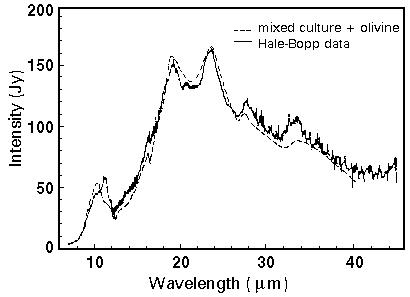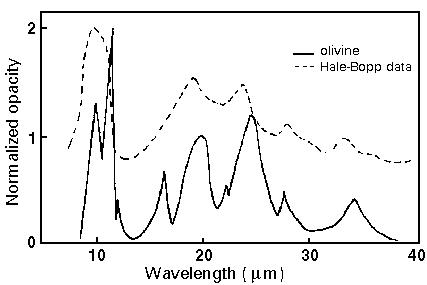*** This article is a simultaneous reprint from naturalSCIENCE, 10 April 1997 *** |
Infrared Radiation from Comet Hale-Bopp1 School of Mathematics, University of Wales Cardiff, P.O. Box 926, Senghennydd Road, Cardiff CF2 4YH, U.K. Wickramasinghe[at]cardiff.ac.uk 2 102 Admirals Walk, West Cliff, Bournemouth BH2 5HF, U.K. SummaryThe infrared spectrum of Comet Hale-Bopp over the wavelength range 7.5 to 45 micrometers, obtained when it was at a heliocentric distance of 2.9 AU, is shown to be consistent with a model dominated by a mixed microbial culture including diatoms with an approximately 10% mass contribution from crystalline olivine. Crystalline olivine by itself is unable to account for the data.Observations of infrared radiation emitted by small particles in the coma of Comet Hale-Bopp have recently been published (Crovisier et al. 1997). Intensity values in units of Janskys (10-26 W m-2 Hz-1 steradian-1) were given at wavelengths from about 7.5 to about 45 micrometers for observations made on 6 October, 1996 when the comet had a heliocentric distance of 2.9 AU. These observations are reproduced without change in Figure 1.  Figure 1. The infrared radiation from Comet Hale-Bopp when it was at a heliocentric distance of 2.9 AU as observed by Crovisier et al. (1997) (solid line). The dashed curve is a normalized spectrum calculated for a mixture of a bioculture, containing about 20% by mass in the form of diatoms, and olivine dust. The olivine is assumed to have a temperature of 175 K and the bioculture a temperature of 200 K. The contributions from the two components are combined so that the olivine contributes 25% to the total flux at the wavelength of 24 micrometers. This corresponds to a mass fraction of about 10% in the form of olivine. Also given in Figure 1, is a curve calculated for submicron particles that are a mixture of two distinct components. An olivine component at a temperature of 175 K, as suggested by Crovisier et al. (1997), and a general bioculture, such as one obtains in springtime in great abundance from rivers and lakes in the U.K., at a temperature of 200 K. The extinction spectrum of the latter over the wavelength range of interest in the present context is dominated by diatom silica, which is a siliceous material that forms the frustules of a large class of diatomaceous algae. The actual spectrum of the bioculture that we used was taken from a paper by Wickramasinghe, Hoyle and Majeed (1989). Diatom silica occurs in this mixed culture in a mass fraction of about 20%. (See also spectra on page 227 of our book The Theory of Cosmic Grains (Hoyle and Wickramasinghe, 1991)). The proportions of the two components, olivine and bioculture, for which the dashed curve of Figure 1 was calculated, were defined by the requirement that the olivine component should produce 25% of the total intensity count at 24 micrometers. Mass-for-mass, olivine is about three times more effective at this wavelength than the bioculture. Thus, the mass fraction of olivine in the mixture for which the curve of Figure 1 was calculated was about 10%. About 90% of the mass was the bioculture. Figure 2 compares the laboratory extinction spectrum of olivine (solid curve) (Hasegawa and Koike 1984) with the extinction required for particles at 200 K to produce the observed intensity counts of Hale-Bopp (dashed curve). The latter is just the Hale-Bopp spectrum of Figure 1 divided by the Planck function Fn(T) for a temperature of 200 K. If the particles in Hale-Bopp were olivine only, as Crovisier et al. (1997) suggest, the two spectra in Figure 2 should be the same, except for small differences due to the temperature of the particles differing somewhat from 200 K. But the margin of difference is vastly too large to be attributed to a temperature effect. The olivine spectrum is much more jagged than the comet spectrum. The latter demands a main contributing material which has an oscillator strength at all wavelengths that is constant to within a factor of about 2, whereas the oscillator strength of olivine falls by a factor of 10 between 20 and 30 micrometers. Similarly, between 10 and 13 micrometers, the oscillator strength falls by a factor of 2 for the comet, but by a factor of 40 for olivine. Between 27 and 40 micrometers oscillator strength falls by only about 1.25 for the comet, but by the large factor of 8 for olivine.  Figure 2. normalized opacity curves for Hale-Bopp dust (dashed curve) and for olivine (solid curve). The dashed curve is calculated by dividing the Hale-Bopp flux values by a Planck function for a temperature of 200 K. The solid curve displays the opacity measurements for olivine dust published by Hasegawa and Koike (1984). The curves are normalized to the value of 2 at their respective peaks. What olivine can validly do, however, is to influence the details of the calculation leading to the curve of Figure 1 at its peaks. The olivine does so at its own major peaks, as may also other minor constituents. Something further is needed at 11.5 micrometers for example, most probably a hydrocarbon. However, the generally very good agreement in Figure 1 shows that the main emission from the comet is well explained by a mixture that is overwhelmingly dominated by a bioculture. It is the disordered arrangement of its constituent SiO4 tetrahedra (Hecky et al. 1973) that permits diatom silica to maintain a roughly constant oscillator strength over a wide band of wavelengths. In this, it differs from most minerals in which the basic molecule, MgSiO3 or Mg2SiO4 in olivine, is arranged in repeated structures that resonate and confine permitted oscillator frequencies to comparatively narrow bands. An alternative explanation of the Hale-Bopp infrared spectrum, should one wish to reject our biological interpretation, is to assume that the bulk of the particles from Hale-Bopp consist of ground-up Pyrextm glass to which must be added a generous quantity of inconsequential organic junk.1
1 Pyrex glass is produced commercially by a very rapid quenching of fused silica. The quenching prevents the SiO4 tetrahedra from reorganizing themselves, producing a disordered structure that is generally similar to diatom silica.
ReferencesCrovisier, J., K. Leech, D. Bockelée-Morvan, T.Y. Brooke, M.S. Hanner, B. Altieri, H.U. Keller and E. Lellouch. 1997. "The spectrum of Comet Hale-Bopp (C/1995 01) observed with the Infrared Space Observatory at 2.9 astronomical units from the sun". Science 275:1904-1907.Hasegawa, H. and C. Koike. 1984. "Far infrared extinction coefficients of minerals of interest for astronomical observations". Laboratory & Observational Infrared Spectra of Interstellar Dust. Royal Observatory Edinburgh, Occasional Report, No.12, pp 137-143. Hecky, R.E., K. Mopper, P. Kilham and E.T. Degens. 1973. "The amino acid and sugar composition of diatom cell-walls". Mar. Biol. 19:323-331. Hoyle, F. and N.C. Wickramasinghe. 1991. The Theory of Cosmic Grains. Kluwer Academic Press, Dordrecht, 307 p. Wickramasinghe, N.C., F. Hoyle and Q. Majeed. 1989. "Mineral and organic particles in astronomy". Astrophys. Sp. Sci. 158:335-349. |
*** This article is a simultaneous reprint from naturalSCIENCE | © 1997, Heron Publishing *** |